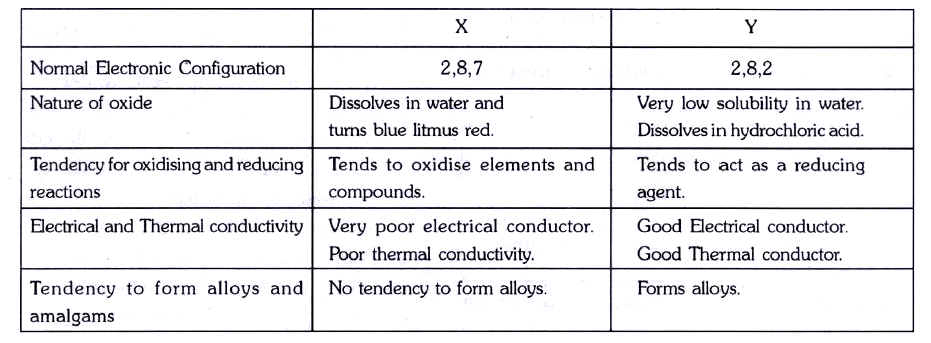Non Metallic oxides plus base is equal to ........
The correct Answer is:A, D
To solve the question "Non Metallic oxides plus base is equal to ........", we can follow these steps:
Step 1: Understand the Nature of Non-Metallic Oxides
Non-metallic oxides are generally acidic in nature. This means that when they react with bases, they can undergo a neutralization reaction.
Hint: Recall that non-metallic oxides typically behave like acids.
Step 2: Identify the Reaction Type
When an acid reacts with a base, the general reaction is a neutralization reaction, which produces a salt and water.
Hint: Remember the general formula for a neutralization reaction: Acid + Base → Salt + Water.
Step 3: Write the General Reaction
The general reaction can be represented as:
Non-metallic oxide+Base→Salt+Water
Hint: Think about what products are formed in a neutralization reaction.
Step 4: Provide an Example
Let’s take carbon dioxide (CO₂) as an example of a non-metallic oxide and calcium hydroxide (Ca(OH)₂) as a base. The reaction would be:
CO2+Ca(OH)2→CaCO3+H2O
Here, calcium carbonate (CaCO₃) is the salt formed, and water (H₂O) is also produced.
Hint: Consider using specific examples to illustrate the general reaction.
Step 5: Conclusion
Thus, the overall conclusion is that when a non-metallic oxide reacts with a base, the products formed are a salt and water.
Final Answer: Non-metallic oxides plus base is equal to salt and water.
Non-metallic oxides are generally acidic in nature. This means that when they react with bases, they can undergo a neutralization reaction.
When an acid reacts with a base, the general reaction is a neutralization reaction, which produces a salt and water.
The general reaction can be represented as:
Non-metallic oxide+Base→Salt+Water
Let’s take carbon dioxide (CO₂) as an example of a non-metallic oxide and calcium hydroxide (Ca(OH)₂) as a base. The reaction would be:
CO2+Ca(OH)2→CaCO3+H2O
Here, calcium carbonate (CaCO₃) is the salt formed, and water (H₂O) is also produced.
Thus, the overall conclusion is that when a non-metallic oxide reacts with a base, the products formed are a salt and water.
Topper's Solved these Questions
- BIOMOLECULESBOOK - CENGAGE CHEMISTRY ENGLISHCHAPTER - BIOMOLECULESEXERCISE - Exercises (Single Correcttype)
80 Videos
- BIOMOLECULESBOOK - CENGAGE CHEMISTRY ENGLISHCHAPTER - BIOMOLECULESEXERCISE - Exercises (Assertion-Reasoning)
15 Videos
- BIOMOLECULESBOOK - CENGAGE CHEMISTRY ENGLISHCHAPTER - BIOMOLECULESEXERCISE - Exercises (Linked Comprehension)
36 Videos
- AROMATIC COMPOUNDS AND ALKYL AND ARYL HALIDES BOOK - CENGAGE CHEMISTRY ENGLISHCHAPTER - AROMATIC COMPOUNDS AND ALKYL AND ARYL HALIDES EXERCISE - Archives Subjective Type
4 Videos
- CARBOXYLIC ACIDS AND THEIR DERIVATIVESBOOK - CENGAGE CHEMISTRY ENGLISHCHAPTER - CARBOXYLIC ACIDS AND THEIR DERIVATIVESEXERCISE - Exercises Archives (Analytical And Descriptive)
34 Videos
Similar Questions
Non-metallic oxides can be acidic or neutral in nature.
View Solution
Using the information above, complete the following:
Non-metallic elements tend to form .......... oxides while metals tend to form ...... oxides.
View SolutionIn the stages involved in the extraction of metals in general - give reasons for following
Reduction of metallic oxides to metal in the extraction of metals from the ores - is based on the position of the metal in the activity series.
View SolutionName a non-metallic oxide which is a reducing agent.
View SolutionWhat is a base metal?
View SolutionThe non-metallic cation is persent in .
View SolutionState the meaning of the term oxide. Give a balanced equation for formation of the following oxides- a. Sulphur dioxide from a non metal b. Zinc oxide from a metal c. Lead oxide from a mixed oxide.
View SolutionGive an example of a metallic oxide that forms salt and water with acids as well as bases. What is the common name given to such oxides?
View SolutionOxidation number is the charge which an atom of an element has in its ion or appears to have when present in the combined state. It is also called oxidation state. Oxidation number of any atom in the elementary state is zero. Oxidation number of a monoatomic ion is equal to the charge on it. In compounds of metals with non metals, metals have positive oxidation number while non metals have negative oxidation numbers. In compounds of two difference elements, the more electronegative element has negative oxidation number whereas the other has positive oxidation number. In complex ions, the sum of the oxidation number of all the atoms is equal to the charge on the ion. If a compound contains two or more atoms of the same element, they may have same or different oxidation states according as their chemical bonding is same or different.
A compound of Xe and F is found to have 53.3% Xe (atomic weight =133). Oxidation number of Xe in this compound is
View SolutionOxidation number is the charge which an atom of an element has in its ion or appears to have when present in the combined state. It is also called oxidation state. Oxidation number of any atom in the elementary state is zero. Oxidation number of a monoatomic ion is equal to the charge on it. In compounds of metals with non metals, metals have positive oxidation number while non metals have negative oxidation numbers. In compounds of two difference elements, the more electronegative element has negative oxidation number whereas the other has positive oxidation number. In complex ions, the sum of the oxidation number of all the atoms is equal to the charge on the ion. If a compound contains two or more atoms of the same element, they may have same or different oxidation states according as their chemical bonding is same or different.
The oxidation state of the most electronegative element in the products of the reaction between BaO2 and H2SO4 are
View Solution
